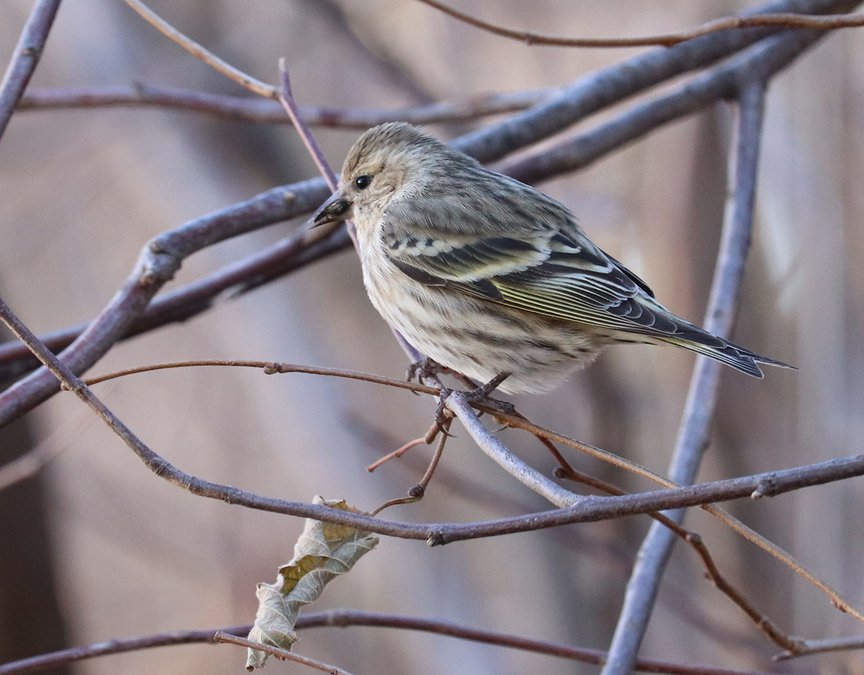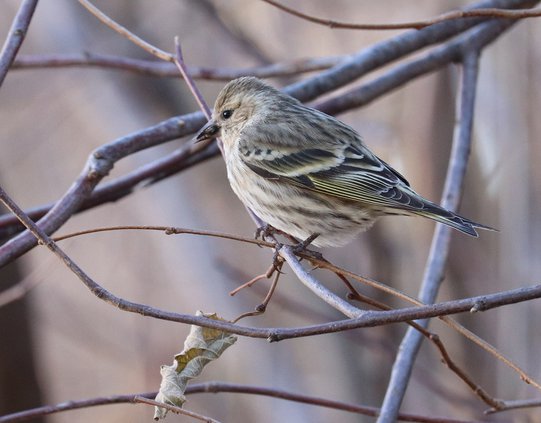A mild start to winter would normally bring a flock of bird watchers to Cheyenne Bottoms and the Quivira National Wildlife Refuge for the annual Christmas Bird Count – but this was no normal year. Although humans have had to forego social gatherings during the COVID-19 pandemic, the birds have not. A record 97 species were documented at the Bottoms – a number matched at Quivira.
Both of the wetlands areas held their Christmas Bird Counts in December, but they skipped the usual social gathering, said Mike Rader, wildlife education supervisor for the Kansas Department of Wildlife, Parks and Tourism. Rader oversaw the Quivira bird count and joined the Cheyenne Bottoms count, led by Curtis Wolf at the Kansas Wetlands Education Center.
Usually, 20 or more people attend the Quivira count, Rader said. “This year was obviously a challenge. We encouraged people not to carpool.” Instead of working in groups, the 11 participants worked alone in their assigned areas and they skipped the traditional shared lunch. The count began at 7 a.m. and ended at 5 p.m. on Dec. 14.
The Cheyenne Bottoms count was done on Dec. 21.
Most years, participants group up in small teams to cover assigned areas. Due to COVID-19 concerns, the 18 participants were assigned individual areas to identify and count as many birds as could be found, Wolf said.
“The hours we were out varied, but some people started about 7:30 a.m. A couple people were out until about 4:30 p.m.,” Wolf said.
The Kansas Ornithological Society typically schedules 50 Christmas Bird Counts between Dec. 12 and Jan. 10, Rader said. At least two were canceled because organizers contracted COVID-19.
For the most part, sites were able to go ahead with their counts, taking COVID safety measures into account.
Cheyenne Bottoms Count
“This was the 46th year the Christmas Bird Count has been held in this area,” Wolf said. “The first was held in 1958, but counts have not been held every year after that.”
Several community members joined staff from the KWEC, the KDWPT and The Nature Conservancy to document a total of 938,599 individual birds.
Numbers have varied over the years. Wolf described the 81 species found in 2018 as “pretty average.” In that count, he reported the number of species had ranged from 68 to 93 over the past 10 years.
The relatively mild winter we’ve had – as well as the mild weather on Dec. 21 – contributed to the diversity counters saw in 2020, he said.
“The Cheyenne Bottoms Christmas Bird Count encompasses a 15-mile diameter count circle that includes Cheyenne Bottoms, as well as most of Hoisington, Great Bend, Ellinwood, and other parts of Barton County.”
Traveling siskins
The 125 pine siskins counted represented the second-highest Christmas Bird Count ever for the species, Wolf said.
Pam Martin, a KDWPT specialist at the Kansas Wetlands Education Center, said 2020 is an “irruption year” for Pine Siskins in Kansas, with reports of high numbers throughout the country. A bird irruption occurs when a species that normally migrates short distances undertakes long-distance migrations for varied reasons.
“According to Audubon Magazine, it’s one of the largest irruptions in recorded history,” Martin said. “Pine siskins are common in Canada and less so in the northern U.S. states. When there is a shortage of conifer seeds in their home range, they fly south in search of food. This year, there is a huge shortage, prompting the large southward migration.”
Martin said she’s also counted 80 to 100 pine siskins at her home feeders periodically since October.
“We also sighted several purple finches that are also not normally found in this area,” she added. “I have six at my home feeders that have been coming in regularly.”
A first for the count
This year one Iceland gull and one common yellowthroat were spotted. This was the first time either species had been reported on the Christmas Bird Count, Wolf said.
Other interesting observations this year include:
• 21 species of waterfowl, including 16 species of ducks
• 143 Great Blue Herons was a high count
• 3 White-faced Ibis were seen. This was the third year these have been reported on this count
• 1 Wilson’s Snipe - only the seventh year these have been reported on this count
• 5 Merlins was a high count
• 1,092 American Coots was a high count
• 379 Sandhill Cranes - only the eighth year these have been reported on this count
• 66 White-winged doves was a high count
• 16 Red-breasted Nuthatches was a high count
• 1 Townsend’s Solitaire - eighth year this species has been reported on this count
• 8 Species of Sparrows
• 36 Cardinals was a high count
• 3 Purple Finches - sixth year this species has been reported on this count
Quivira
At the Quivira count, Rader said they also counted 97 species on the official count day, plus three more for the count week. They saw 50 swans, mostly tundras, but no trumpeter swans. Sandhill crane numbers were up as more and more often they are staying later in the season. They counted six species of shorebirds. “That’s not typical,” he said. Usually there are only one or two shorebird species at Quivira for the Christmas Bird Count. This year, however, “it wasn’t cold enough to drive them farther south.”
On the other hand, there was a marked decrease in the number of woodland birds, also due to less severe weather. There aren’t a lot of eastern redcedar trees this year, which means fewer cedar berries and thus fewer robins and bluebirds.
They saw 76 bald eagles, “a pretty good number,” and lots of other raptors. That indicates there are plenty of mice, he said. “And we had open water, which also helps.”
Growing interest
An estimated 70.4 million people go out-of-doors to watch birds one or more times per year, according to the U.S. Forest Service. Bird watching has surged in popularity during the pandemic. After all, the birds are not on lockdown and it is an activity that can be enjoyed alone or with your family or social bubble.
“You can watch from your backyard,” Rader said, adding he heard that people are buying binoculars at record levels. The good news for central Kansas residents is that Quivira and Cheyenne Bottom, both named Wetlands of International Importance, are on the Central Flyway, the territory where North America’s migratory birds establish their north and south routes between nesting and wintering areas.
About the bird count
The Christmas Bird Count is a long-standing program of the National Audubon Society, with over 100 years of community science involvement. It is an early-winter bird census, where thousands of volunteers across the U.S., Canada, and many countries in the Western Hemisphere go out over a 24-hour period on one calendar day to count birds. Each count takes place in an established 15-mile wide diameter circle, and is organized by a count compiler. Count volunteers follow specified routes through a designated circle, counting every bird they see or hear all day.
Audubon’s 121st Christmas Bird count began Dec. 4 and will continue through Jan. 5.
The Kansas Ornithological Society counts continue until Jan. 10. Rader said the Black Wolf Count in Ellsworth County is yet to come. It will be held on Jan. 9.
Cheyenne Bottoms Christmas Bird Count
Dec. 21, 2020
97 species
Snow Goose 29,571
Ross’s Goose 5
Greater White-fronted Goose 556
Cackling Goose 250
Canada Goose 467
Wood Duck 1
Blue-winged Teal 1
Northern Shoveler 756
Gadwall 178
American Wigeon 13
Mallard 924
Northern Pintail 374
Green-winged Teal 275
Redhead 31
Ring-necked Duck 4
Lesser Scaup 3
Bufflehead 16
Common Goldeneye 17
Hooded Merganser 5
Common Merganser 134
Ruddy Duck 11
Unidentified Ducks 2,450
Northern Bobwhite 5
Wild Turkey 135
Greater Prairie-Chicken 1
Ring-necked Pheasant 4
Pied-billed Grebe 7
Rock Pigeon 19
Eurasian Collared-Dove 77
White-winged Dove 66
Mourning Dove 18
American Coot 1,092
Sandhill Crane 379
Wilson’s Snipe 1
Ring-billed Gull 823
Herring Gull 137
Iceland Gull 1
American White Pelican 5
Great Blue Heron 143
White-faced Ibis 3
Northern Harrier 43
Sharp-shinned Hawk 4
Cooper’s Hawk 3
Bald Eagle 9
Red-tailed Hawk 102
Rough-legged Hawk 3
Barn Owl 2
Eastern Screech-Owl 1
Great Horned Owl 8
Belted Kingfisher 5
Red-bellied Woodpecker 15
Downy Woodpecker 14
Hairy Woodpecker 5
Northern Flicker 57
American Kestrel 16
Merlin 5
Prairie Falcon 3
Loggerhead Shrike 3
Blue Jay 14
American Crow 20
Horned Lark 21
Black-capped Chickadee 3
Red-breasted Nuthatch 16
White-breasted Nuthatch 17
Winter Wren 1
Marsh Wren 8
Carolina Wren 10
Golden-crowned Kinglet 2
Ruby-crowned Kinglet 1
Eastern Bluebird 1
Townsend’s Solitaire 1
American Robin 148
Northern Mockingbird 1
European Starling 5,270
Cedar Waxwing 101
House Sparrow 254
House Finch 65
Purple Finch 3
Pine Siskin 125
American Goldfinch 78
Lapland Longspur 1
Field Sparrow 1
Fox Sparrow 3
American Tree Sparrow 595
Dark-eyed Junco 593
White-crowned Sparrow 11
Harris’s Sparrow 67
Song Sparrow 52
Spotted Towhee 1
Eastern Meadowlark 149
Western Meadowlark 87
Meadowlark sp. 466
Red-winged Blackbird 889,788
Brown-headed Cowbird 24
Brewer’s Blackbird 2
Common Grackle 21
Great-tailed Grackle 1,285
Common Yellowthroat 1
Northern Cardinal 36





